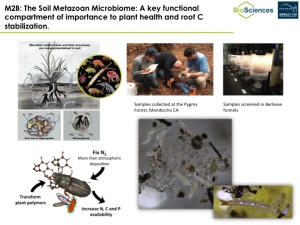
PIs: Javier Ceja Navarro (ESD), Trent Northen (LSD)
Unearthing the role of small soil animals and their microbes in the transformation and movement of nutrients in soil: Multicellular animals (Metazoans) have impacted the development of our planet since they first appeared in the Pre-Cambrian period. It is known that in the early Cambrian, the digging and burrowing of animals in the seafloor, diminished the availability of P in the ocean, which lead to reduced C burial that in turn reduced atmospheric and oceanic O2 concentrations. Nowadays, arthropods (animals with an exoskeleton and segmented body) and nematodes (worms) represent more than 60% of all living species on Earth, with an estimated global mass of 1 to 14 billion tons. These groups of metazoans function as ecosystem engineers. Through both physical and chemical transformation of soil they are providing modified habitats for soil microorganism and other soil fauna, and thereby playing an important role in the cycling of nutrients. Besides, during their evolution, metazoans incorporated microbes and their genes to their living machinery. The associated microbes cooperate by conveying processes such as N fixation, transformation of complex plant polymers and the degradation of toxic compounds, an association that gives to metazoans the ability to survive even on diets with negligible nutrient content.
Existing studies of the biological processes driving the cycling of soil nutrients have focused principally on the free-living and plant-associated soil microorganisms. However, most of the previous efforts have neglected the role soil metazoans in the global cycling of soil nutrients. We propose that the soil metazoan associated microbiome is a critical compartment of nutrients transformation given their widespread distribution their influential role in the modification of the soil environment. We propose to study metazoan-associated microorganisms with a specific focus on plant associated nematodes and arthropods. The application of a multi-scale approach will enable the characterization of the contribution of soil metazoans, and their microbiomes to nutrient cycling, and a better understanding of the regulation of microbial activity by their environment, i.e. the metazoan host.
